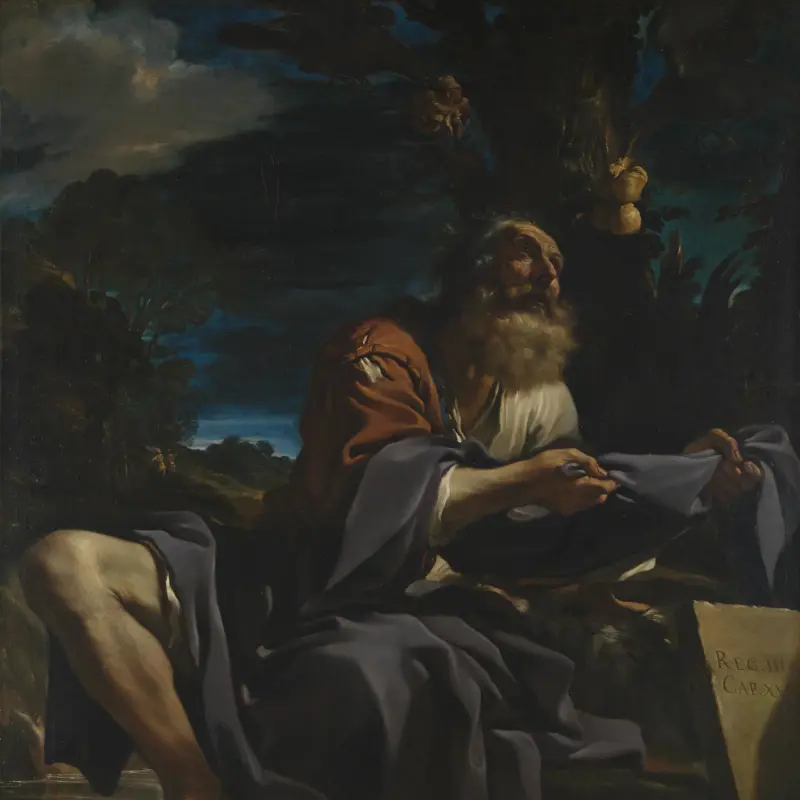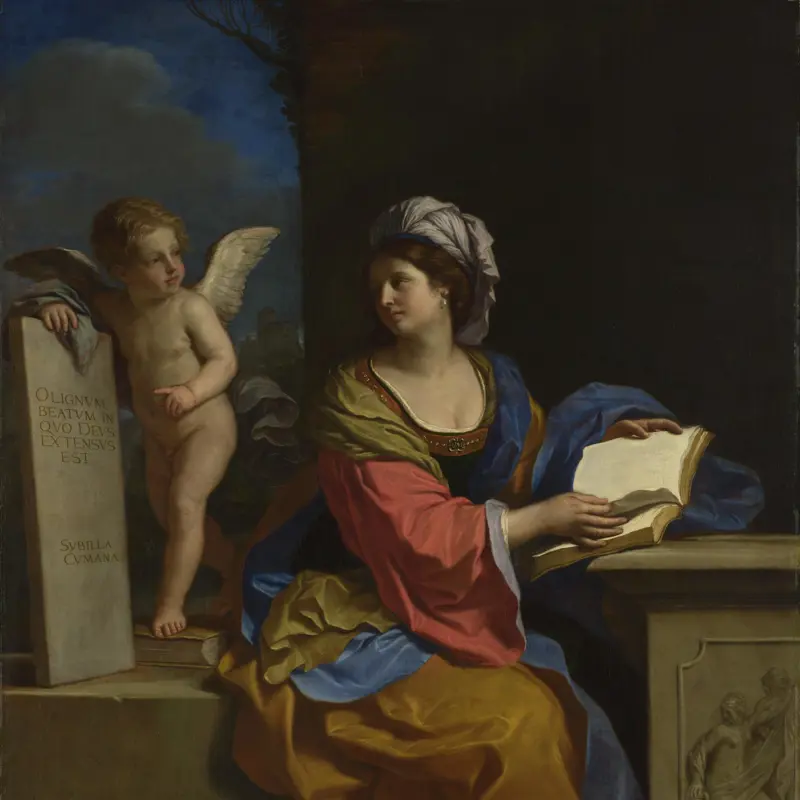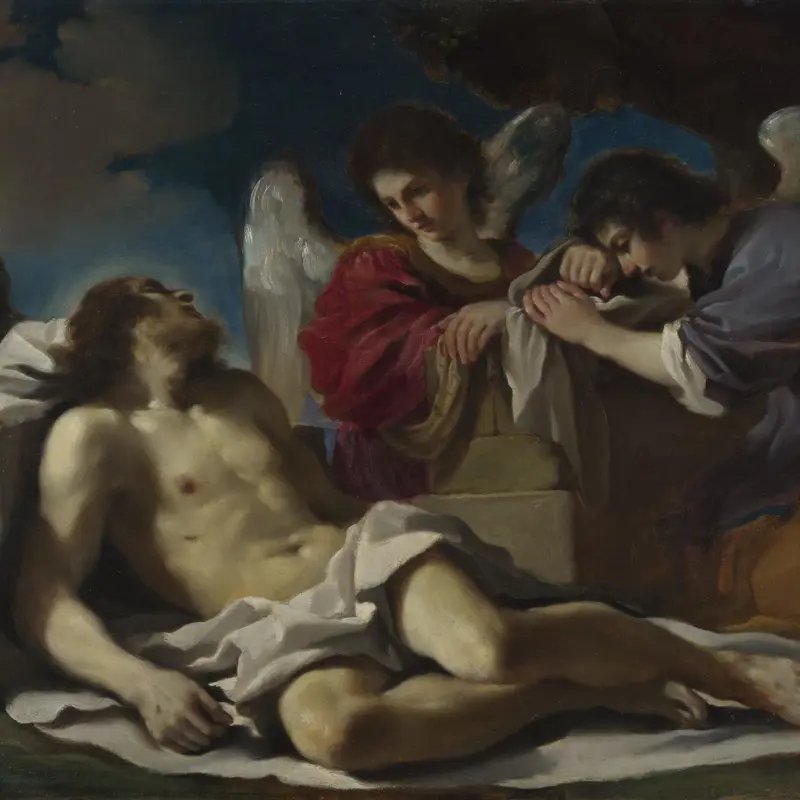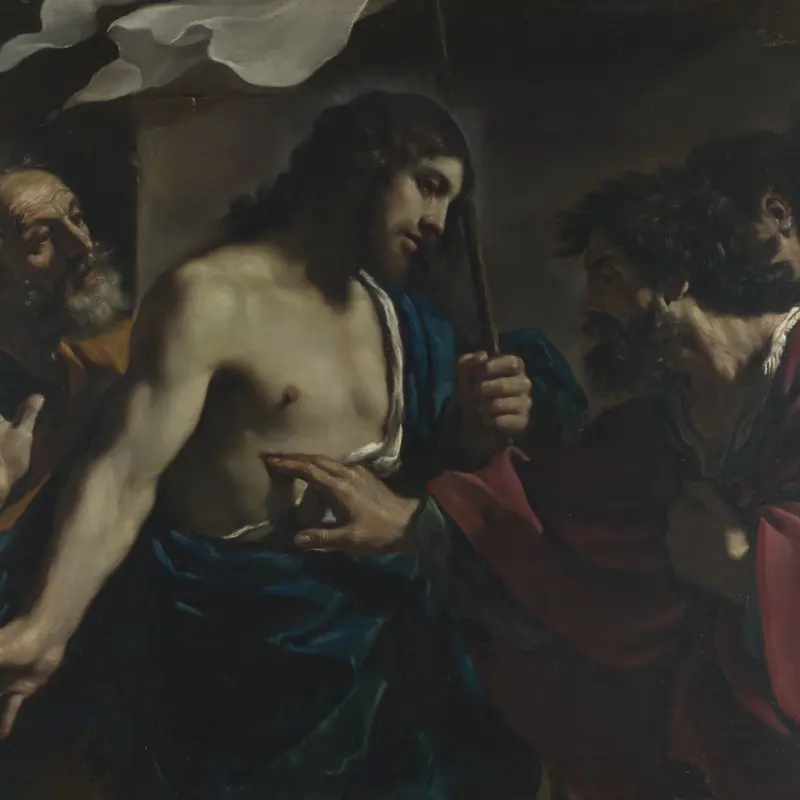Guercino, 'The Angel appears to Hagar and Ishmael', 1652-3
About the work
Overview
The story of Hagar and Ishmael is told in the Old Testament Book of Genesis. Unable to have a child with his wife, Sara, Abraham has a son called Ishmael by her Egyptian maidservant, Hagar. When the aged Sara miraculously conceives and gives birth to Isaac, she demands that Hagar and Ishmael are banished to the wilderness, where they are left to die.
In this painting, Hagar turns from her son so she does not have to watch him die. As she weeps, an angel appears to her and reveals a water source nearby – visible in the bottom left corner of the painting – saving their lives. Hagar’s anguish is the focus of the painting. She is seated in the centre of the composition, poised and dignified, and her gleaming tears convey her intense sorrow.
Probably painted in the second half of 1652, this picture is an example of Guercino’s late classicising style, greatly influenced by Guido Reni.
Key facts
Details
- Full title
- The Angel appears to Hagar and Ishmael
- Artist
- Guercino
- Artist dates
- 1591 - 1666
- Date made
- 1652-3
- Medium and support
- Oil on canvas
- Dimensions
- 193 × 229 cm
- Acquisition credit
- Presented by the Trustees of Sir Denis Mahon's Charitable Trust through the Art Fund, 2013
- Inventory number
- NG6623
- Location
- Not on display
- Collection
- Main Collection
Provenance
Additional information
Text extracted from the ‘Provenance’ section of the catalogue entry in Gabriele Finaldi and Michael Kitson, ‘Discovering the Italian Baroque: The Denis Mahon Collection’ (exh. cat. National Gallery, London, 1997), London 1997 and supplemented by the National Gallery’s Annual Report, ‘The National Gallery: Review of the Year, April 2012 – March 2013’; for further information, see the full catalogue entry.
Bibliography
-
1678C.C. Malvasia, Felsina pittrice: Vite de' pittori bolognesi, Bologna 1678
-
1758C.-N. Cochin, II, Voyage d'italie, Paris 1758
-
1802R.R. Warner (ed.), A Tour through the Northern Counties of England, London 1802
-
1865J.C. Robinson, Catalogue of the Works of Art Forming the Collection of Robert Napier of West Shandon, Dumbartonshire, London 1865
-
1937H. Walpole, Horace Walpole Correspondence, ed. W.S. Lewis, 48 vols, New Haven 1937
-
1953G. Briganti, 'The Mahon Collection of Seicento Paintings', The Connoisseur, CXXXII, 1953, pp. 4-18
-
1958F.M. Godfrey, A Student's Guide to Later Italian Painting, 1500-1800, London 1958
-
1968D. Mahon, Il Guercino: Catalogo critico dei dipinti (exh. cat. Palazzo dell'Archiginnasio, 1 September - 18 November 1968), Bologna 1968
-
1969D. Mahon, Il Guercino: Catalogo critico dei disegni (exh. cat. Palazzo dell'Archiginnasio, 1 September - 18 November 1968), Bologna 1969
-
1984G. Feigenbaum, Lodovico Carracci: A Study of His Later Career and a Catalogue, n.p. 1984
-
1988L. Salerno, I dipinti del Guercino, Rome 1988
-
1991D.M. Stone, Guercino: Catalogo completo dei dipinti, Florence 1991
-
1991M. Helston et al., Guercino in Britain: Paintings from British Collections (exh. cat. The National Gallery, 28 June - 31 July 1991), London 1991
-
1991D. Mahon, Giovanni Francesco Barbieri, Il Guercino, 1591-1666 (exh. cat. Museo civico archeologico, 6 July - 10 November 1991; Schirn Kunsthalle, 2 December 1991 - 9 February 1992; National Gallery of Art, Washington, 15 March - 17 May 1992), Bologna 1991
-
1991N. Turner and C. Plazzotta, Drawings by Guercino from British Collections, (exh. cat. British Museum, 17 May - 18 August 1991), London 1991
-
1992D. Mahon, Guercino: Master Painter of the Baroque (exh. cat. Pinacoteca Nazionale, 6 July - 10 November 1991; Schirn Kunsthalle, 2 December 1991 - 9 February 1992; National Gallery of Art, Washington, 15 March - 17 May 1992), Washington 1992
-
1993National Gallery, The National Gallery Report: April 1992 - March 1993, London 1993
-
1997G. Finaldi et al., Discovering the Baroque: The Denis Mahon Collection (exh. cat. The National Gallery, 26 February - 18 May 1997), London 1997
-
2001
C. Baker and T. Henry, The National Gallery: Complete Illustrated Catalogue, London 2001
-
2001A. Brogi, Ludovico Carracci (1555-1619), Bologna 2001
-
2004D. Mahon et al., Guercino: Poesia e sentimento nella pittura del'600 (exh. cat. Palazzo Reale (Milan), 27 September 2003 - 18 January 2004), Milan 2004
-
2005M. Pulini et al., Nel Segno di Guercino: Guercino as Master Draughtsman: Drawings from the Mahon Collection (exh. cat. Pinacoteca Civica, 28 May - 31 July 2005; Ashmolean Museum, 2 November 2005 - 16 January 2006), London 2005
-
2005M. Pulini, Nel segno di Guercino: Disegni dalle collezioni Mahon, Oxford e Cento (exh. cat. Pinacoteca Civica, 28 May - 31 July 2005; Ashmolean Museum, 2 November 2005 - 16 January 2006), Cento 2005
-
2014National Gallery, The National Gallery: Review of the Year, April 2012 - March 2013, London 2014
About this record
If you know more about this work or have spotted an error, please contact us. Please note that exhibition histories are listed from 2009 onwards. Bibliographies may not be complete; more comprehensive information is available in the National Gallery Library.









